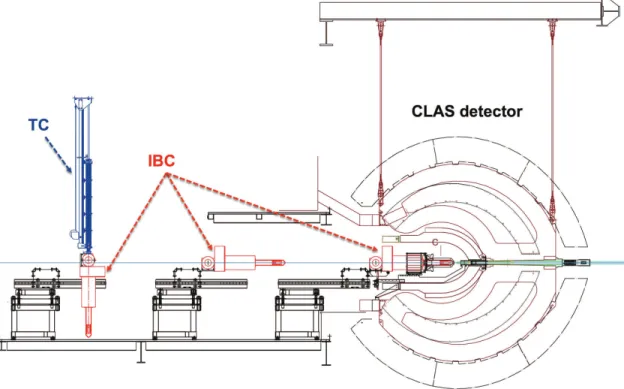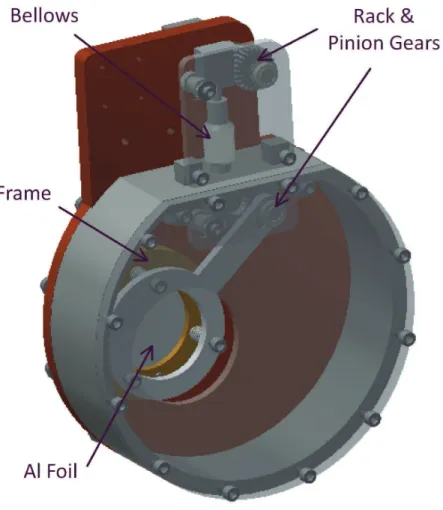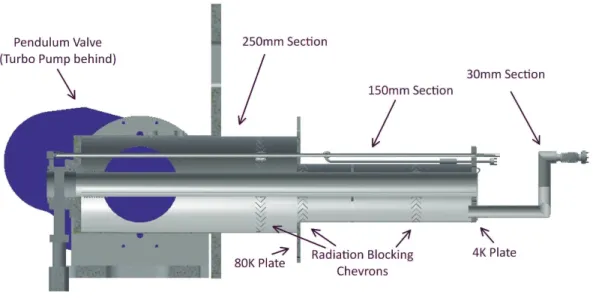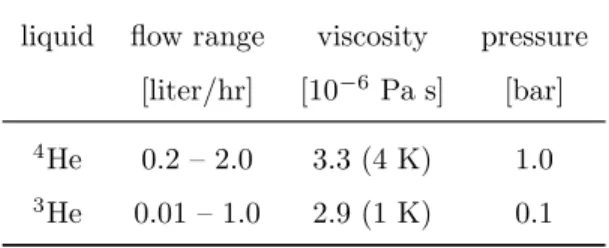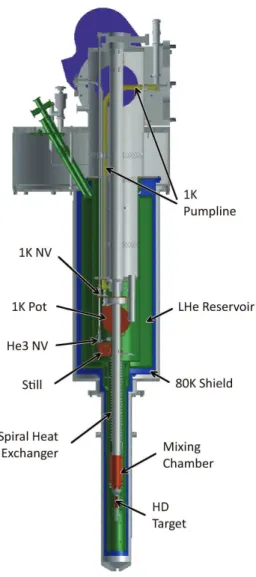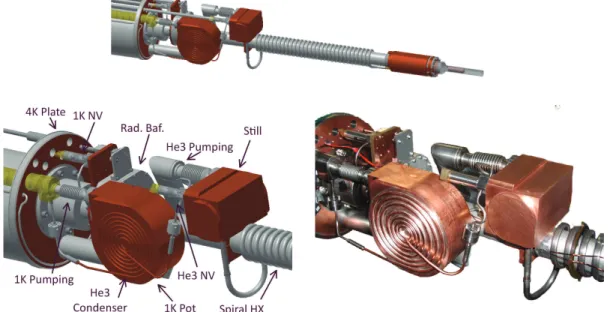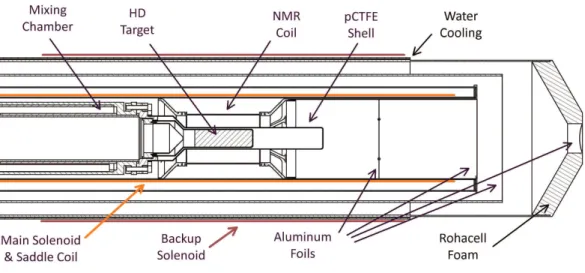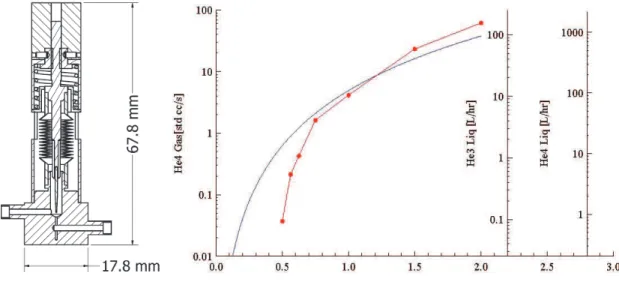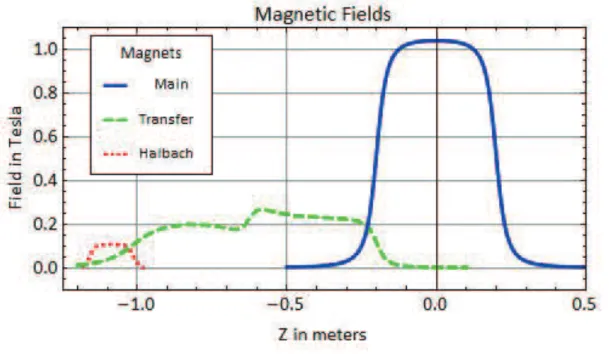A cryostat to hold frozen-spin polarized HD targets in CLAS:
HDice-II
M. M. Lowrya,∗, C. D. Bassa,1, A. D’Angeloa,b, A. Deura, G. Dezerna, C. Hanrettyc, D. Hod, T.
Kageyaa, D. Kashya, M. Khandakere, V. Lainea,f, T. O’Connellg, O. Pastora, P. Pengc, A. M.
Sandorfia, D. Sokhanh,2, X. Weia, M. Zareckya
aThomas Jefferson National Accelerator Facility, 12000 Jefferson Av, Newport News, VA 23606, USA bUniversita’ di Roma\Tor Vergata”, and INFN Sezione di Roma \Tor Vergata”, Via della Ricerca Scientifica, 1
I-00133 Roma, Italy
cUniversity of Virginia, 1400 University Av, Charlottesville, VA 22903, USA dCarnegie-Mellon University, 5000 Forbes Av, Pittsburgh, PA 15213, USA
eNorfolk State University, 700 Park Av, Norfolk, VA 23504, USA fUniversit´e Blaise Pascal, 34 Avenue Carnot, 63000 Clermont-Ferrand, France gUniversity of Connecticut, 115 N Eagleville Rd, Storrs-Mansfield, CT 06269, USA
hInstitut de Physique Nucleaire, Bat 100 - M053, Orsay 91406, France
Abstract
The design, fabrication, operation, and performance of a helium-3/4 dilution refrigerator and superconducting magnet system for holding a frozen-spin polarized hydrogen deuteride target in the Jefferson Laboratory CLAS detector during photon beam running is reported. The device operates both vertically (for target loading) and horizontally (for target bombardment). The device proves capable of maintaining a base temperature of 50 mK and a holding field of 1 Tesla for extended periods. These characteristics enabled multi-month polarization lifetimes for frozen spin HD targets having proton polarization of up to 50% and deuteron up to 27%.
Keywords: dilution refrigerator, polarized target, hydrogen deuteride, frozen-spin target PACS: 07.20.Mc Cryogenics, 84.71.Ba Superconducting magnets, 29.25.Pj Polarized targets
Contents
1
1 Introduction 2
2
∗Corresponding author.
Email address: mlowry@jlab.org(M. M. Lowry)
1
Present address: Le Moyne College, 1419 Salt Springs Road, Syracuse, NY 13214, USA
2
Present address: University of Glasgow, Glasgow G12 8QQ, Scotland, UK
Preprint submitted to Nuclear Instruments and Methods in Physics Research Section A December 18, 2015
2 In-beam Cryostat 3 3 2.1 Design Considerations . . . 3 4 2.2 Central access . . . 6 5 2.3 Helium-3/4 pumping . . . 8 6
2.4 Main helium-4 reservoir . . . 9
7
2.5 80 K shield . . . 10
8
2.6 4 K plate, 1 K pot and helium-3 return . . . 11
9 2.7 Dilution unit . . . 11 10 2.8 Needle valves . . . 13 11 2.9 Magnets . . . 14 12 2.10 NMR . . . 16 13 2.11 Pumping skid . . . 16 14
2.12 Computer control system . . . 17
15
3 Operation and Performance 18
16 3.1 Cooldown . . . 18 17 3.2 Target transfer . . . 18 18 3.3 Rotation . . . 19 19
3.4 Photon and Electron Beam Running . . . 20
20 3.5 Warmup . . . 20 21 4 Discussion 20 22 5 Acknowledgements 21 23 1. Introduction 24
This is the second in a series of papers that describe the apparatus necessary for the condensing,
25
polarizing, handling and bombarding of frozen-spin polarized hydrogen deuteride (HD) targets.
Ex-26
periments with polarized targets are essential to unravel the amplitudes in meson photo-production.
27
First proposed in 1967 [1] and first used in photo-production experiments only recently [2], this
28
type of polarized target has many attractive features for such measurements, but its operation
29
is considerably more complex than that of a conventional polarized target. Several commercial
cryostats and magnet systems are used in the production process, as well as two specially designed
31
and constructed devices. The first paper [3] detailed the motivation for the target system, its
32
physics principles, the HD target production and utilization process, and one of the two
custom-33
built cryostats required, the transfer cryostat (TC). This paper describes the design and operation
34
of the second custom-built cryostat, the in-beam cryostat (IBC), that held polarized HD targets in
35
the center of the CEBAF Large Acceptance Spectrometer (CLAS) for the recently-completed meson
36
photoproduction experiment E06-101 [4] at Jefferson Laboratory. The in-beam cryostat discussed
37
here is the third generation in a series, and is significantly superior in both long-term reliability
38
and operating temperature. Discussions of the earlier versions may be found in refs. [5, 6]. A third
39
paper is in preparation which will deal with the NMR measurement and RF manipulation of the
po-40
larization and with the polarization lifetime dependences on temperature, field and concentrations
41 of metastable impurities. 42 2. In-beam Cryostat 43 2.1. Design Considerations 44
The device required to hold frozen-spin HD targets within the CLAS detector at Jefferson
Lab-45
oratory presents some unique challenges. The physical dimensions are dictated by the simultaneous
46
requirements of supporting target transfer operations with the TC and holding that target at the
47
center of CLAS. Since the target transfer is best done vertically while the access to CLAS is
hor-48
izontal, the refrigerator must operate in both orientations and while traveling between the center
49
of CLAS and a point sufficently distant to allow vertical access to the cryostat (see Figure 1). The
50
central access of the cryostat must accomodate the transfer cryostat liquid nitrogen section out
51
to its maximum extension where a docking mechanism must open a 77 K shutter opener on the
52
TC[3] and withstand the 1800 Nt thrust of the transfer cryostat without excessive thermal loading
53
of either cryostat. Past this shutter opener, the extension of the pumped-liquid-helium TC center
54
tube with target must be accommodated out to the target holder of the IBC. At the same time,
55
the outer envelope diameter is set by the bore of the CLAS detector and, specifically, the bore of
56
the CLAS Start Counter [7], and the CLAS detector’s large angular acceptance requires thin, low-Z
57
materials to enable escape of particles originating in the target over the range from 0 to 150 degees.
58
The thermal performance required is dominated by the need to maintain long polarization
Figure 1: Target manipulations inside Experimental Hall B at Jefferson Lab. Steps left to right: transfer cryostat (TC - in blue) loads frozen-spin HD target into the in-beam cryostat (IBC - in red); IBC is rotated horizontally; IBC is rolled into CLAS for experiments. (A pumping skid, mounted on the same rails as the IBC, is omitted for clarity.)
into a requirement for a base temperature less than 100 mK. A secondary goal is to maintain a
61
refrigerator temperature under 300 mK during tests with multi-GeV electron beams, where a 1 nA
62
beam deposits 2.5 mW in the target used for E06-101. A dilution refrigerator is the only viable
63
option for continuous operation.
64
The polarization lifetime is not only affected by temperature but also by magnitude of the
65
holding field. To that end the device requires four magnets of varying maximum strength reflecting
66
the varying lengths of time the target is expected to remain in them and the difficulty in producing
67
that field. The main holding field is defined as a nominally 1.0 Tesla superconducting solenoid,
68
centered on the target and representing a compromise between lifetime and energy loss of reaction
69
products passing through the coils. A separate, backup, room temperature solenoid must generate
70
of order 0.01 T in order to guard against main field loss due to equipment failure or operator error.
71
Between the TC docking point and the main solenoid, a superconducting transfer solenoid with a
72
holding field of at least 0.1 T is needed for transfer operations. Finally, a superconducting saddle
73
coil must produce a transverse field of at least 0.05 T to allow the holding field to rotate between
74
pointing up and pointing down the beamline.
75
A final requirement, possibly novel for a dilution refrigerator, is mandated by the U.S.
Depart-76
ment of Energy, that pressure vessels meet the requirements of the ASME Boiler and Pressure Vessel
77
Code [8], which includes vessels with internal or external operating pressures exceeding 103 kPa,
78
and with an inner diameter, width, height, or cross section diagonal greater than 152 mm. Because
79
of the thin windows for beam entry and exit, this applies to the internal volumes as well as the
80
outer shell. Satisfying this rule results in significant design complications and costs involving types
81
of materials and thicknesses, joint methods and geometries, and testing regimes.
82
An immediate consequence is the design decision for all stainless-to-stainless joints to be TIG
83
welded, and all stainless-to-copper and all copper-to-copper joints to be vacuum brazed.
Aluminum-84
to-stainless joints were commercial friction welds3 and aluminum-to-aluminum joints were a com-85
bination of TIG and e-beam welding. The exceptions to this are demountable joints which are all
86
indium-sealed. As fabricated, neither the friction welds nor the e-beam welds proved to be vacuum
87
tight and had to be sealed by painting with epoxy4. 88
3
Meyer Tool and Mfg., Inc.
4
Figure 2: IBC central access cut-away showing gate valve, thermal compensation bellows, shutter opener, radiation baffle, mixing chamber and HD target.
2.2. Central access
89
The central access tube is the axis of the design and a separate vacuum space from the main
90
cryostat vacuum, although it is not intended to support a greater differential pressure than about a
91
tenth atmospheric. It is the path by which HD frozen-spin targets, which are mounted on threaded
92
copper cooling rings [3], are transferred to and from the target-receiving threads on the mixing
93
chamber. It is also the beam path to the target. Figure 2 shows a cut-away model view of this
94
assembly.
95
From the upstream face of the ISO63 gate valve to the mid-plane support plate of the helium-4
96
reservoir (see Section 2.4), the access is a 63 mm diameter, 1.11 m long stainless steel tube, with a
97
102 mm long formed-bellows to relieve thermal stress mounted just downstream of the gate valve.
98
Beyond the 4 K support plate is the demountable shutter opener and downstream of that is the
99
can containing the thermal radiation baffle.
100
The thermal radiation baffle blocks room-temperature radiation from penetrating to the dilution
101
unit and can be swung out of the way for target transfer (see Figure 3). The swing is controlled by
102
dual rack-and-pinion gear combinations to translate the rotary motion of the actuator rod to linear
103
motion of a small vacuum sealed bellows and back to the rotary swing of the baffle. The baffle
104
center is a double layer of 29 mm diameter, 12.5 µm thick, aluminum foil allowing the photon (or
105
electron) beam to pass with minimal interaction. The surrounding frame is held in thermal contact
Figure 3: IBC radiation baffle. The metal downstream plates are rendered as transparent in order to show the interior details of the mechanism that moves the swing arm in and out of the beam path.
with the upstream copper wall of the can by three springs. Indium seals on the end walls allow
107
access to the interior mechanism.
108
Most of the 0.94 m distance from the mid-plane helium-4 plate to the bottom stop of the target
109
holder is occupied by a 38 mm diameter stainless steel tube on which the major components of the
110
helium-3/4 circulation are mounted (see Sections 2.6 and 2.7). This includes the copper mixing
111
chamber vacuum brazed onto the downstream end. A polyimide spider5 is mounted on the tube 112
at the point, downstream of the still, where it enters the helium-4 reservoir snout. (It is visible in
113
the right panel of Figure 6.) It ensures the centering of the tube and removes at least some of the
114
natural droop of such a long horizontal thin tube.
115
The final 149 mm of the central access is provided by a pCTFE shell just outside the target
116
shell and extending an additional 60 mm downstream. The downstream end of this shell duplicates
117
the pCTFE thickness of the target cell seen by the beam to that point, and hence the event rate,
118
in a location separable by CLAS from events generated in the target. This provides a continuous
119
measure of the pCTFE background contribution.
120
2.3. Helium-3/4 pumping
121
The primary support structure between the upstream end of the cryostat and the dilution unit
122
(see Section 2.7) is the pump line for the helium-3/4 still. As shown in Figure 4, the stainless steel
123
line steadily reduces in diameter starting at 250 mm between room temperature and the 80 K plate,
124
down to 150 mm between the 80 K and 4 K plates, and then ranging from 30 mm to 20 mm on
125
either side of the formed bellows connecting to the still. Three sets of chevron baffles (1 in the
126
250 mm section and 2 in the 150 mm region) block room temperature radiation from reaching the
127
still. The upstream end is a reducing cross with ISO200 flanges on which are mounted a pair of
128
turbo pumps6. These pumps together have an 1800 ltr/s nominal pumping speed. This translates 129
to a molar flow of 1.6 milli-moles/s at 2 Pa. That flow rate implies 1.1 mW of nominal cooling at
130
0.1 K and 5.4 mW at 0.3 K. To allow operation at higher still pressures and thus higher potential
131
flow rates, one of the turbo pumps can be removed and replaced with a fixed line to a Roots pump
132
stack7 with 1440 ltr/s nominal pumping speed. Exhausts from all pumps are fed to two scroll 133
5
DuPont, Vespel -SP1R 6
Varian, Turbo-V 1001 Navigator
7
Figure 4: IBC still pumping line. The steadily increasing diameter maintains pumping speed as the density drops with increasing temperature of the gas. The chevrons block the direct path for room temperature thermal radiation to reach the still.
pumps8 and the gas handling system mounted on the pumping skid located 2-3 meters away (see 134
Section 2.11).
135
2.4. Main helium-4 reservoir
136
The reservoir used to hold liquid helium-4 at a vapor pressure close to atmospheric is two,
137
joined, toroidal cans (see Figure 5). The upstream stainless steel one, the main volume, has an
138
inner diameter of 212 mm and an outer diameter of 324 mm. The downstream aluminum one,
139
the snout (lower part of Figure 5), has diameters of 70 mm and 95 mm, respectively, shrinking to
140
90 mm near the target. A thicker region near the base of the snout has the aluminum-to-stainless
141
transitions previously mentioned in Section 2.1. The outside of the reservoir is covered in ten layers
142
of super-insulation and the downstream end of the volume enclosed by the reservoir is capped by a
143
48 µm aluminum foil. The reservoir is shown in green in Figure 5.
144
Three of the four magnets described in Section 2.9 are mounted on the interior surfaces of the
145
8
inner walls. Their leads exit through the middle two of the four 25 mm tubes extending at an angle,
146
30 degree from the axis, at the upstream end (see top of Figure 5). Besides the 3 sets of magnet
147
leads, the tubes carry voltage taps for the normal conductor portion of the leads and wires for two,
148
duplicate, level sensors. The third tube holds the liquid helium delivery lance and the fourth is the
149
exhaust. The room-temperature plate that is O-ring sealed to the vacuum can and carries the four
150
tubes also has vacuum feedthroughs for the NMR cabling (see Section 2.10), which is mounted on
151
the helium can exterior.
152
Also on the upstream end, at the lowest point when horizontal, a 6.4 mm diameter tube enters
153
and extends to the downstream end of the main can to pickup liquid for cooling the mid-plane
154
helium-4 plate and for transfer to the 1 K pot (see Section 2.6). Similarly, another 6.4 mm diameter
155
tube connects at the highest point when horizontal and picks up helium boiloff vapor to cool the
156
80 K plate and shield (see Section 2.5).
157
2.5. 80 K shield
158
The boiloff vapor taken from the liquid helium-4 reservoir by the 80 K system flows into a
159
5.5 turn 220 mm diameter copper coil and then exits the cryostat through a 300 W PID controlled
160
heater. The gas flow rate is set by a mass flow controller feeding a bellows pump9. The coil is 161
bolted to the 80 K plate, a copper-clad stainless steel plate making the transition from 150 mm to
162
250 mm diameter in the helium-3/4 still pumping line (see Figure 4 and Section 2.3). Bolted to
163
the same plate, is an aluminum thermal radiation shield (blue region of Figure 5). It consists of a
164
356 mm diameter by 0.87 m long main can and a 108 mm inner diameter by 0.84 m long snout.
165
The diameter of the snount at the base is enlarged to 143 mm for a 76 mm length to accommodate
166
the aluminum to stainless transitions of the helium reservoir snout (see Section 2.4 and Figure 5).
167
The thickness is 3.2 mm except for the final 0.34 m of the downstream end, the target region, where
168
it is thinned to 0.5 mm. The outside of the 80 K shield is covered in ten layers of super-insulation
169
and the downstream end opening is closed by a 48 µm aluminum foil.
170
Platinum thermistors, two located on the coil, one on the main can, and one on the snout, show
171
that with typical helium gas flow rates of 20 ltr/min the coil temperature is about 65 K, the main
172
can about 70 K and the snout about 80 K.
173
9
2.6. 4 K plate, 1 K pot and helium-3 return
174
The plate, referred to as the 4 K plate, that separates the 30 mm to 150 mm transition in the
175
still pumping line (see Section 2.3 and Figure 4) is the principle mechanical support for the liquid
176
helium-4 reservoir (see Section 2.4). As shown in Figure 6, this plate also forms the upstream wall
177
of the active cooling portion of the cryostat. In order to assure its temperature a portion of the
178
liquid helium syphoned from the main reservoir is vaporized in a half-loop of 3 mm copper tubing
179
soldered to the copper cladding of the plate at a rate determined by a mass flow controller. Typical
180
helium gas flow rates of 15 ltr/min keep the plate at about 6 K.
181
The 1 K pot is a cylindrical volume mounted to the beam-right of the central access, attached
182
to the central access just downstream of the radiation baffle can (see Section 2.2) and oriented with
183
its axis parallel to the cryostat rotation axis (see Figures 1, 5 and 6). It has an internal volume
184
of 450 ml and is filled with liquid syphoned from the main reservoir through a needle valve (NV)
185
located on the radiation baffle can (see Section 2.8 and Figure 6). A pumpline for the 1 K pot
186
parallels the still pumping line ranging in diameter from 12.7 mm at the pot to 25.4 mm at the
187
4 K plate to 40 mm immediately beyond the cryostat. Pumps, located on the pumping skid (see
188
Section 2.11), consist of a nominal 200 ltr/s Roots pump10 backed by two scroll pumps11. 189
Returning helium-3 gas is precooled in a 3 meter long, 3.2 mm diameter, stainless tube coiled
190
inside the 1K-pot pumpline from room temperature down to the 4 K plate (see Figure 6). The
191
tube then exits the pumpline and connects to a spiral heat exchanger brazed to the the side of the
192
1 K pot. The pumpline heat exchanger proved quite effective, typically delivering 2 K helium-3 to
193
the spiral on the side of the 1-K pot and thereby significantly reducing the load on the 1 K pot.
194
Finally, a needle valve mounted on the still provides the flow impedance to maintain the necessary
195
condensing pressure for transforming the gas to liquid.
196
2.7. Dilution unit
197
The still, shown in Figures 5 and 6, is made from an oxygen-free electrolytic (OFE) copper
198
box with a 10.0 cm long by 5.1 cm diameter cylindrical cavity having a tear-drop crosssection (see
199
Figure 6). It is mounted on the top (when horizontal) of the central access with its axis parallel to
200
10
Alcatel, RSV 601B
11
the cryostat rotation axis(see Figures 1, 5 and 6). The tear-drop shape ensures the connection to
201
the spiral heat exchanger is at the low point, independent of cryostat orientation.
202
Tubing for the incoming liquid helium-3 forms a heat exchanger inside the still. The 1.2 mm OD
203
by 0.2 mm wall german silver (Cu Ni18 Zn20) capillary is spiral wound six times within the body
204
of the still. The still temperature is controlled by a heater made from a NiCr thick-film resistor
205
inside a copper slug bolted to the outside of the still.
206
The capillary continues out of the still into a 7.9 mm OD by 0.5 mm wall stainless tube spiral
207
wrapped about the central access (see Section 2.2). Together they form a counterflow, tube-in-tube,
208
spiral heat exchanger (HX) between the helium-3/4 concentrate mixture returning to the mixing
209
chamber and the dilute mixture proceeding to the still. After about 1 meter of linear distance,
210
the inner capillary is enlarged to a 2.0 mm OD by 0.25 mm wall german silver capillary. After
211
an additional 2 meters, two 300 mm lengths of 2.4 mm OD by 0.36 mm wall copper tube are
212
inserted. The copper tubes are sintered inside and out with 0.5 mm thick layers of copper powder
213
and separated from each other by 150 mm of the 2.0 mm capillary. A final length of the 2.0 mm
214
capillary emerges inside the mixing chamber from a 6.3 mm diameter extension of the 7.9 mm
215
diameter tube. This is at the downstream end of the mixing chamber and at the bottom when in
216
horizontal orientation. The returning concentrate then bubbles up through the heavier dilute to the
217
top of the mixing chamber. This injection of the return concentrate below the phase boundary is a
218
distinctive feature of the design. Dissolved helium-3 in the dilute mixture is driven up the 6.3 mm
219
extension, through the 7.9 mm tube and into the still, by osmotic pressure. There it is distilled
220
from the mixture by the applied still heat and pumped away, eventually returning as concentrate
221
to complete the cooling cycle.
222
The mixing chamber volume (Figure 7) is constructed from two OFE copper cylindrical shells,
223
an outer 62.5 mm OD by 2.3 mm wall shell extending up from the downstream end plate and an
224
inner 40.1 mm OD by 1.5 mm one extending down from the upstream end. Layers of copper powder
225
1.5 mm thick are sintered to the interior surfaces of the copper shells. The inside length of the
226
volume is 103 mm. On the downstream end of the mixing chamber a copper target holding ring with
227
the necessary M35x1 thread is bolted with an indium seal both to preserve the vacuum integrity
228
of the central access and to ensure good thermal contact. Two calibrated ruthenium oxide RTD
thermometers12 are mounted on the ring. The accuracy of the calibrations is ±4 mK at 50 mK. 230
The resistance is measured by an AC resistance bridge13 on the pumping skid (see Section 2.11) 231
with a pre-amp immediately adjacent to the cryostat.
232
2.8. Needle valves
233
The in-beam cryostat requires two needle valves. One controls the flow to the 1K-pot and the
234
other serves as a variable condensing restriction in the helium-3/4 circuit. The requirements for
235
such valves are simple to state: 1) No leaks to the outside, although vacuum tight shut off is not
236
required. 2) Low thermal leaks to room temperature and 3) good flow control of low viscosity
237
cryogenic liquids in the low flow regime. Additional considerations are low dead volume and small
238
size. The numerical flow requirements are given in Table 1.
239
Table 1: Needle valve flow requirements.
liquid flow range viscosity pressure [liter/hr] [10−6 Pa s] [bar]
4He 0.2 – 2.0 3.3 (4 K) 1.0
3He 0.01 – 1.0 2.9 (1 K) 0.1
A design was developed to meet these needs. A cross section is shown in Figure 8. A tungsten
240
carbide needle14with a diameter of 0.7 mm and a tip angle of 5.0◦is vacuum brazed into one end of 241
a stainless steel stem. The other end is threaded and positions the needle part way into a 0.5 mm
242
cylindrical hole in the stainless steel base. Base and stem are connected by a 9.5 mm OD welded
243
bellows15. A cover holds the nut for the thread, the connection to a control rod, and a spring16to 244
suppress backlash. A guide to prevent bellows rotation and limit travel pokes through slots in the
245
cover. The design is shown in Figure 8 along with a plot of volume flow versus turns open showing
246
experimental results in red from tests with room temperature He4 gas and a theoretical prediction
247
in blue based on a simplified geometry. Additional scales give the flows for the two cryogenic liquids,
248
12
Lake Shore Cryotronics, RX-102A and RX-102B
13
PicoWatt, AVS-47B
14
Semprex Corporation, p/n 31-5071.
15
helium-3 at 1 K and 0.1 bar and helium-4 at 4 K and 1.0 bar. The plot shows the middle of the
249
required flow range occurs at about half a turn open and also depicts the large flows available for
250
the initial cool down. The needle valves (NV) are visible in Figure 6, both in the photograph and
251
in the model of the cryostat interior.
252
2.9. Magnets
253
As shown in Figure 7, a 4K-liquid-helium-volume surrounds the target region and contains the
254
superconducting magnets that are cooled by direct contact with liquid (see Section 2.4). Outside
255
of this is an 80K-shield of aluminium that is indirectly cooled by contact with evaporating liquid
256
helium vapor at the upstream end of the IBC. Beyond this is the vacuum can with a water-cooled
257
jacket and the room-temperature backup solenoid wound on that jacket.
258
In the liquid helium reservoir are the main solenoid, the saddle coil, and the transfer solenoid
259
that are each wound from Supercon 54S43 superconducting wire. This multistrand wire consists
260
of 54 filaments of NbTi embedded within a copper stabilizer with a ratio of 1.0 : 1.3 of NbTi to
261
copper. The diameter of each multistrand wire bundle is 0.229 mm and an additional layer of
262
varnish insulator increases the overall diameter to 0.254 mm.
263
The room-temperature-to-helium transitions for all three sets of magnet leads are an update of
264
the helium vapor cooled design of K. R. Efferson[9]. The leads for the three magnets utilize two
265
high current, 8-pin feedthroughs mounted on 2.75 Del Seal flanges17. These feedthroughs are rated 266
for 23 A per pin but the air-side connector is only rated for 17 A per pin. On the main reservoir
267
side, each pin connects to a 1.6 mm diameter copper braid inside a 2.2 mm inner diameter pTFE
268
tube. The braid is soldered to the superconducting wire at the bottom, downstream end of the
269
large diameter portion of the main reservoir. One pair of pins is used by the transfer magnet,
270
three pairs for the main solenoid and four pairs for the saddle coil. Voltage taps are made at room
271
temperature and at the normal-to-superconducting joint on each lead of the three magnets. This
272
gives three voltage differences for each magnet; two monitor the voltage drop on the normal portions
273
and the third monitors the superconducting status of the coil. Two flow controllers, one on each
274
8-pin feedthrough, are adjusted manually to set the helium vapor flow from the reservoir to the
275
helium return system through the two groups of pTFE tubes on the basis of the voltage drops in
276
17
the normal sections of the leads.
277
The transfer magnet is two double-layer solenoids in series, one extending from the center of
278
the liquid helium reservoir to the downstream end of the large diameter, a 400 mm length with a
279
220 mm diameter, and one from the base of the snout to within 200 mm of the target center, a
280
420 mm length, at 72 mm diameter. When powered to 17 A during the transfer of a polarized HD
281
target, as shown in Figure 9, the coil provides a > 0.15 T holding field over the full travel distance
282
of the target from the transfer cryostat’s Halbach magnet docked in the opener (see Figure 2) to
283
the main solenoid magnet of the in-beam cryostat. Current is supplied by a manually controlled
284
power supply18. 285
Both the transfer magnet and the main solenoid were fabricated on a lathe-based winding
286
machine, as shown in Figure 10. The main solenoid has a total length of 400 mm and shares the
287
same center as the HD. This solenoid is wound from four layers of wire and has an inner diameter
288
of 71.32 mm. Voids between wire bundles are filled with Stycast 1265 epoxy19. A one-wire width, 289
two-layer deep gap in the center gives a design uniformity over the target volume of 10−4 but 290
fabrication imperfections may limit the actual uniformity. The main solenoid produces a nominal
291
field of 1 T at a current of 51 A, as shown in Figure 9, and is driven by a power supply20controlled 292
by software on the NMR computer system.
293
A saddle coil is placed around the main solenoid and also centered on the target. The coil is
294
used to temporarily hold the target polarization transverse to the cryostat axis while the direction
295
of the main solenoid is reversed, thus reversing both the H and D polarizations. The saddle coil is
296
made from a pair of single layer, 54-turn coils that are wrapped around the cylindrical nose of the
297
IBC to form a bedstead coil geometry. The pair is 150 mm long at a diameter of 73.58 mm and
298
encased in a 0.25 mm layer of Stycast 1265 epoxy. The saddle coil generates a field of 0.075 T at a
299
current of 60 A and is driven by a manually controlled power supply21. 300
A non-superconducting, room temperature, backup solenoid with a diameter of 290 mm and a
301
length of 280 mm is also centered on the HD target. The backup solenoid is wound on a water
302
cooled substrate integral to the snout vacuum can as indicated in Figure 7. It has three layers of
303
18
Cryomagnetics, Model CS-4
19
Emerson Cummings (Henkel Loctite), Stycast 1265.R 20
Oxford Instruments, Intelligent Power Supply IPS120-20
21
wire, 1.02 mm diameter aluminum plus 50 µm thick insulation. The backup solenoid produces a
304
field of 0.014 T at a current of 9 A supplied by a manually controlled power supply22. 305
Also apparent in Figure 7 is the relatively open geometry for viewing particles emitted from
306
the target over a polar angle from 0 degrees back to 150 degrees. All the cylindrical shells outside
307
the target are either thin aluminum or pCTFE. The only higher Z material is the 4 layers of
308
superconducting wire in the main solenoid and the single layer in the saddle coil (the 3 layers of wire
309
in the backup solenoid are aluminum). The seemingly thick material supporting the downstream
310
aluminum exit window is a low-density, high-strength, closed-cell foam23. 311
2.10. NMR
312
The target polarization is monitored and manipulated by radio frequency electromagnetic
in-313
teractions generated and received by coils that are wound on a 41.7 mm diameter pCTFE mandrel
314
surrounding the target. The mandrel is supported by an array of 2.5 mm thick pCTFE ribs (see
315
Figures 7 and 11) connecting it to a pair of 69.6 mm diameter, coaxial pCTFE hoops . The ribs are
316
oriented to sit in the shadow of the CLAS torus coils to minimize their impact on particle energy
317
loss. The downstream hoop is attached to a 69.6 mm diameter, 0.5 mm thick aluminum support
318
tube that is a slide fit within the liquid helium snout. At the end of the snout, the coil leads are
319
connected to coax cables that lead to the vacuum feedthroughs on the helium reservoir exhaust plate
320
(see Section 2.4). The coil approximates a “bird cage” geometry, with a cosine current variation, in
321
order to improve the RF field uniformity. The coil assembly is shown in Figure 11. Figure 12 shows
322
typical absorption and dispersion signals obtained obtained with these coils for both protons and
323
deuterons. Further information on the construction, theory and results of these coils, and on the
324
computer-controlled system that transmits and receives radio-frequency NMR signals with them,
325
can be found in Reference [10].
326
2.11. Pumping skid
327
The pumping skid (see Figure 13) provides a single support structure for the many
supplemen-328
tary pumps, flow controllers, valves, heaters, and gauges needed by the multiple gas flows generated
329
by the cryostat. Two sealed pumps24 (170 ltr/min each) move exhaust helium gas into the helium 330
22
Kepco, BOP 50-20MG
23
Evonik Industries, Rohacell 110 WF
24
gas recovery system from five flow controllers: one on the main reservoir, one on the 4K plate, one
331
on the 80 K coil, and one on each of the two magnet lead multipin feedthroughs. Also mounted
332
on the skid are the two scroll pumps25 backing the 1 K pot Roots pump26. They exhaust into the 333
recovery system directly.
334
The helium-3/4 gas handling is done by a computer-interfaced gas-handling system27. Aug-335
menting it are a backing pump subsystem of two scroll pumps28, an impurity trapping subsystem 336
of two coldtraps in an automatically re-filled liquid nitrogen dewar and a 280 liter dump tank
stor-337
age subsystem (sufficient for the mixture of 50 liters of helium-3 and 185 liters of helium-4) . All
338
the components are mounted on the pumping skid.
339
In addition, the readout and control electronics are mounted on the skid. The three temperaure
340
sensors operating below 0.5 K are readout by a multi-channel AC resistance bridge29, the other 341
twelve are readout by two multi-sensor temperature monitors30. Diaphragm gauges and two in-342
strument controllers31 monitor pressures at nine points in the gas recovery system. Two control 343
modules32 handle the six flow controllers. Three level sensor readouts33 monitor the levels in the 344
main reservoir, the 1 K pot, and the liquid nitrogen trap which has an autofill module as well. A
345
controller34provides remote operation of gas system valves and the scroll pumps. All the electronics 346
and pumps are powered through four uninterruptible power supplies mounted on the skid as well.
347
These can power the IBC systems for upto ten minutes, providing more than sufficient time for a
348
backup diesel generator to start and reach full speed.
349
2.12. Computer control system
350
All of the skid-mounted control and monitoring elements (see Section 2.11), in turn, interface
351
to a rack mounted computer that reads them out and sets parameters. This was done through a
352 25 Edwards, XDS35i 26 Alcatel, 601B 27
Oxford Instruments, Intelligent Gas Handler
28
Edwards, XDS35i
29
PicoWatt, AVS-47B
30
LakeShore Cryotronics, Model 218E
31
Edwards Vacuum, ASG and TIC
32
Aalborg, SDPROC
33
Cryomagnetics, Model LM-510
34
program, written in LabVIEW35, that displays values on a system schematic and allows parameter 353
values to be adjusted. The computer program also feeds the information into an EPICS36 data 354
stream for offline storage and use by the accelerator control and cryogenic plant, and transfers the
355
data into a local utility for periodic logging and into a local strip chart utility to allow monitoring
356
of trends and recent history.
357
3. Operation and Performance
358
3.1. Cooldown
359
The refrigerator is cooled down from room temperature while the cryostat is vertical. The
360
liquid helium transfer lance is placed into an inital fill cone that directs the flow down to the base
361
of the snout and liquid helium is transferred. The boil-off cools the magnet leads, the 1K-pot, the
362
4K-plate, the 80K-plate and, if a vapor-cooled transfer line is used, the transfer line itself. It takes
363
from one to three days for the main reservoir to cool enough to begin accumulating liquid helium,
364
depending on the transfer rate, ranging from 15 ltr/hr to 1.5 ltr/hr. Once the snout is filled, the
365
main reservoir level will begin to indicate and the 1K-pot will begin to fill. At that point the
366
delivery lance is lifted out of the inital fill cone and the level in the reservoir rises to the nominal
367
operating level of 40-60%. A small amount of helium-3/4 gas mixture is circulated (2-3 ltr/min) in
368
the dilution unit to cool it. More mixture is required as the unit cools until eventually the entire
369
inventory is condensed in. This process takes one to three days. Then power is applied to the still
370
to maintain circulation and the refrigerator cools to base temperature in 6 to 12 hours.
371
3.2. Target transfer
372
As shown in Figure 1, the transfer cryostat (TC) can be attached to the in-beam cryostat (IBC)
373
while the IBC is vertical. The joining spool piece is evacuated, gate valves are opened and the
374
vacuum of the TC is joined to the centeral access of the IBC. As described in Reference [3], the
375
liquid nitrogen temperature portion of the TC can be lowered down the central access to mate the
376
TC thermal radiation shutter with its opener on the 4 K plate of the IBC. This also seals the central
377
access to prevent room temperature radiation from shining down the central access. Thus the IBC
378
35
National Instruments
36
radiation baffle can be opened without significantly loading the dilution unit. The loading increases
379
as the 2 K center tube of the TC is lowered through the unit to touch the target-holding threaded
380
ring on the mixing chamber, typically, producing a temperature of 0.2 to 0.4 K. Clockwise rotation
381
(if a target is to be inserted, counterclockwise if one is to be removed) attaches the target to the
382
mixing chamber (or TC) and then detaches it from the the TC (or mixing chamber). Mechanical
383
energy is dissipated on the unit and along with the thermal contact to the 2 K TC typically produces
384
a temperature increase to about 0.4 K to 0.6 K but the helium-3/4 flow rate does not markedly
385
increase. The refrigerator starts to cool back down as soon as the threads disengage and continues
386
to do so as the TC center tube is raised back into the liquid nitrogen section, the IBC baffle is
387
closed and the TC is withdrawn from the central access. The IBC typically returns to base in 3 to
388
6 hours.
389
These features can be seen in Figure 14 which charts the mixing chamber temperature history
390
during a typical target transfer (loading of target 19b; for subsequent polarization history of this
391
target see Figure 15). After the initial touch of the 2 K target ring on the 60 mK holder, the target
392
is rotated counterclockwise until the starts of the two threads are aligned, producing a perceptible
393
1 mm drop. A clockwise rotation then screws in the outer, right-hand (RH) threads, steadily
394
increasing the thermal contact between the TC and the IBC and generating frictional heating
395
spikes. When the RH threads bottom out, further rotation releases and unscrews the inner,
left-396
hand (LH) threads, steadily lowering the thermal contact but producing yet more frictional spikes.
397
When the LH threads decouple, the IBC continues to cool and the spikes cease.
398
3.3. Rotation
399
In order to place the target in the beam, the cryostat must be rotated to its horizontal position.
400
There are two areas of concern in this process. One is the upstream wall of the helium reservoir.
401
Because the reservoir is stainless steel, a temperature difference exists between the wall areas in
402
contact with liquid and those only in contact with vapor. A slow rotation is thus needed to avoid a
403
sudden boiloff and rapid pressure rise that could interfere with liquid helium delivery and possibly
404
uncover the magnet. The other area of concern is the 1 K pot pumpline. If the pot has been allowed
405
to overfill, there can be liquid in the bottom of the pumpline which will flow up the line just as
406
the cryostat reaches horizontal. This will rapidly cool the return helium-3 capillary, condensing the
407
gas and collapsing the return pressure. When the 1 K helium-4 evaporates and the cooling stops,
the helium-3 will vaporize in the small volume capillary generating an over pressure that can stop
409
circulation and force mixture into the dump. This can be avoided by care in setting the 1 K pot
410
level before executing the procedure.
411
Following bombardment, the cryostat must return to vertical in order to remove the expended
412
target. This process is easier than the rotation above because the two issues mentioned are not a
413
problem in this direction.
414
3.4. Photon and Electron Beam Running
415
A photon beam on target produces no discernable effect on the cryostat beyond the necessity
416
to operate it with a networked computer running Remote Desktop. The story is quite different for
417
electron beam bombardment. The multi-GeV, minimum-ionizing beam deposits about 2.5 mW/nA
418
in a 50 mm long target [11]. Heating from a nano-Amp beam thus requires running at maximum
419
circulation rate and still produces mixing chamber temperatures in the 150 to 250 mK range.
420
3.5. Warmup
421
Once the target is transferred out, the cryostat can be warmed to room temperature. The first
422
step is to recover the helium-3 portion of the mixture, which takes about 2 hours. The larger and
423
higher latent heat helium-4 portion takes another 12 to 24 hours, depending on heater power used.
424
At this stage, the delivery of liquid helium to the main bath is stopped and the reservoir empties
425
in a few hours. The cryostat then warms to near room temperature in about two days.
426
4. Discussion
427
The principal function of the IBC is to hold a polarized HD target for experiments in the Jefferson
428
Laboratory Hall B spectrometer, CLAS. Figure 15 depicts the target polarizations of H and D during
429
a portion of the E06-101 (g14 ) experiment and exhibits that the IBC’s combination of magnetic field
430
and temperature produces lifetimes for the polarizations which is much longer than the experimental
431
run. In fact, the cooling performance during this 6 months run was excellant, maintaining a
432
temperature of 50 to 70 mK except for target manipulations, magnetic field manipulations including
433
two “quench” incidents, and the electron beam tests. The two magnetic failures were due to a
434
malfunctioning magnetic power supply and a computer network failure resulting in a drop in liquid
435
helium delivery that uncovered the magnet. Both were caused by events external to the cryostat.
Figure 15 also illustrates several polarization manipulations for target 22b. At day 21, following
437
target implantation, the polarizations of H and D are shared so that H goes down from 50% to 26%
438
while D rises from 16% to 26%. On day 35, the H polarization is flipped with a 90% efficient RF
439
adiabatic fast passage. Some loss of D occurs at the same time. Shortly thereafter, the holding field
440
direction is reversed, reversing both polarization directions, with minimal impact on H polarization
441
magnitude but with some loss of D. A similar loss occurs again at day 45 when the field is rotated
442
back. A likely explanation is that, the D polarization lifetime is too short at the low fields used for
443
the H RF flip and available from the transverse saddle coil for the field rotation.
444
Another measure of the in-beam cryostat’s performance is the cooling power, the external heat
445
applied to the mixing chamber to warm to various temperatures. Measurements of this are plotted
446
in Figure 16 where the cooling powers have been normalized to the circulation rate. The 1.4
milli-447
moles/s in Figure 16 was the maximum flow available during the g14 run because of a partial block
448
in the return helium-3 line resulting from an air leak during cooldown. Subsequent measurements
449
determined that flow rates up to 1.9 milli-moles/s could be used although the helium-3 content
450
of the return gas drops to 89% and the still temperature warms to 860 mK. This indicates the
451
still limits operation at even higher flow rates. Nevertheless, the temperatures in Figure 16 are
452
all consistent with theory [12] and, at the 1.9 milli-moles/s flow rate, a temperature of 250 mK is
453
implied for 5 mW heating, more than satisfying the design goal of 300 mK for electron running.
454
In summary, the device described here satisfies all the design goals and has proven to be robust
455
and reliable for multiple target manipulations and the long term operation with beam on solid
456
polarized hydrogen-deuteride targets.
457
5. Acknowledgements
458
The authors wish to thank J. Alston, D. Anderson, C. Apeldoorn, W. Clemens, J. Dail, J.
459
Dickinson, P. Hemler, D. McCay, R. W. Teachey, S. Williams, D. Tilles and the Jefferson Lab
Hall-460
B technical crew for their dedicated assistance during the design, construction and commissioning
461
of the in-beam cryostat described herein. A. Comer and the Jefferson Lab Target Group provided
462
invaluable assistance in the design and in fabrication of the copper sinters and tubing spirals. This
463
material is based upon work supported by the U.S. Department of Energy, Office of Science, Office
464
of Nuclear Physics under contract DE-AC05-06OR23177.
References
466
[1] A. Honig. Phys. Rev. Lett. 17 (1967) 1009-1010.
467
[2] S. Hoblit, et al. (the LEGS Collaboration). Phys. Rev. Lett. 102 (2009) 172002.
468
[3] C. D. Bass, et al. Nucl. Instrum. Methods A 737 (2014) 107.
469
[4] K. Ardashev, et al. (the CLAS Collaboration), Proposal: E06-101 “N∗ resonances in 470
pseudoscalar-meson photo-production from polarized neutrons in ~H · ~D and a complete
de-471 termination of the γn → Ko Λ amplitude”, 2006. 472 <http://www.jlab.org/exp prog/proposals/06/ PR06-101.pdf> 473
[5] M. Rigney, et al. Nucl. Instrum. Methods A 356 (1995) 116.
474
[6] X. Wei, et al. Nucl. Instrum. Methods A 526 (2004) 157.
475
[7] Y. G. Sharabian, et al. Nucl. Instrum. and Meth. A 556 (2006) 246-258.
476
[8] ASME Boiler and Pressure Vessel Committee, 2010 ASME Boiler & Pressure Vessel Code,
477
Section VIII, Divisions 1&2 (American Society of Mechanical Engineers, 2010).
478
[9] K. R. Efferson, Rev. Sci. Instrum. 38 (1967) 1776-9.
479
[10] X. Wei, et al., Boosting deuteron polarization in HD targets in Proceedings of PSTP 2013,
480
<http://pos.sissa.it/archive/conferences/182/016/ PSTP2013 016.pdf>.
481
[11] M. M. Lowry, et al., Electrons on the HD target in Proceedings of PSTP 2013,
482
<http://pos.sissa.it/archive/conferences/182/015/ PSTP2013 015.pdf>.
483
[12] R. Radebaugh, NBS Technical Note No.362 (National Bureau of Standards,1967).
Figure 5: IBC cross section as viewed with the cryostat vertical, as for target loading. An 80 K radiation shield (blue) surrounds the 4 K liquid helium bath (green), which, in turn, surrounds the dilution-cooling components.
Figure 6: Model (above and left) and photograph (right) of the 1 K pot region. The liquid He4 level in the 1 K pot is controlled by its needle (NV), visible at the upper left. Returning helium-3 enters first through a precooling helical coil within the 1 K pot pumping line (not visible here), next through a spiral condenser line brazed to the 1 K pot and then through a pressure reducing NV mounted on the still. The liquid helium-3 flows through a coil inside the the still and then into the inner tube of the tube-in-tube spiral heat exchanger (HX) shown at lower right.
Figure 7: Cross section through the snout of the IBC in the target region. The section shows the mixing chamber, HD target, NMR coil support, the pCTFE psuedo-target, and the location of various Al foils in the beam path.
Figure 8: Design and performance of needle valves used to control flow to the 1 K pot and pressure in the helium-3 condenser. Calculated (blue curve) and measured (red points) flows for helium-4 gas at 300 K and 1.0 bar differential pressure are plotted against the valve opening in numbers of turns of the #3-56 UNF thread that positions the tungsten-carbide needle. The additional scales to the right shown implied flows for helium-3 liquid at 1 K and 0.1 bar and helium-4 liquid at 4 K and 1.0 bar.
Figure 9: Plot of the magnitude of the fields on axis generated by two of the IBC magnets as a function of distance from the target position. The main solenoid is in blue and the transfer solenoid in dashed green. The TC Halbach permanent magnet array [3] is shown in dotted red at the docking position to illustrate the holding fields during target loading. The rapid change in the transfer solenoid field at about Z = −0.6 is the transition between the large diameter main bath portion and the small diameter snout portion. The other two IBC magnets are not plotted. The saddle coil is not used during target loading and would only just be visible at this scale (0.075 T). The backup coil is too weak to show up (0.014 T).
Figure 10: IBC main solenoid during winding of the second of four layers. Also visible upstream of it is the already wound snout portion of the transfer solenoid. Just visible in the the middle of the main solenoid is a gap of one wire width created by an aluminum fin that is only two layers high. The reduction in turn density improves field uniformity.
1-turn posts 1-turn posts 2-turn posts (Transmitter) 2-turn posts (Receiver) complete cross-coil assembly
Figure 11: NMR coil wiring plan and photograph of completed pair of crossed coils. Each coil is composed of 6 turns, three on either side of the target. Two of the turns on a side subtend an angle of 144 degrees and the third an angle of 56.8 degrees. The assembly approximates a “bird cage” geometry and improves the uniformity of the RF field [10].
Figure 12: Typical absorption and dispersion signals for H and D generated by frozen-spin polarized HD targets as seen with the IBC NMR coils. The RF frequency is held constant (11.15 MHz for H, 1.757 MHz for D) and the magnetic field is ramped. The vertical axis is response in arbitrary units and the horizontal axis is data point number (0.076 Gauss per point). Full length of the trace is 300 Gauss. The D line is not split by the deuteron electric quadrupole moment because the HD crystal symmetry results in no electric field gradient.
Figure 13: IBC pumping skid and cryostat during initial tests. The aluminum wire of the backup solenoid (see Section 2.9) is visible between the two yellow bands on the IBC snout.
Figure 14: IBC mixing chamber temperature during a typical target transfer, in this case, the loading of target 19b. The varous stages of the transfer: 1) touch of the TC on the mixing chamber, 2) aligning of the thread starts, 3) threading in of the right-hand (RH) outer threads on the target ring, 4) release and un-threading of the left-hand (LH) inner threads, and 5) the beginning of return to base temperature, are marked.
Figure 15: Polarization history of two of the HD targets during the six-month run period of g14. Various events such as transfer of polarization from H to D, reversal of H polarization, rotation of the main field direction (causing both H and D to reverse) and an accidental magnet quench are shown [10].
Figure 16: Normalized Cooling Power (heater power ÷ helium-3 flow rate) versus temperature. Blue dots are measured with turbo pumping while green squares and red diamonds are measured with Roots pumping. The colored lines connecting the points are to guide the eye. The black curve is the theoretical performance for an ideal refrigerator [12].
